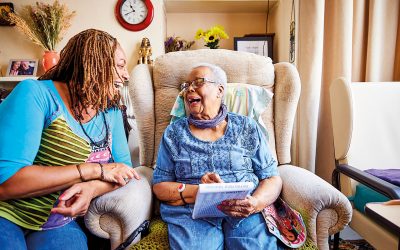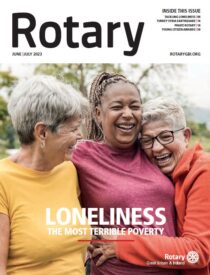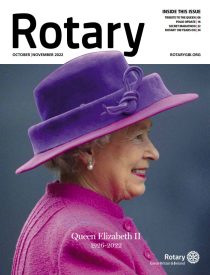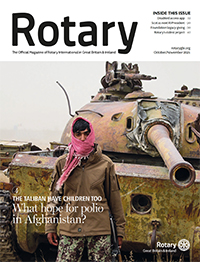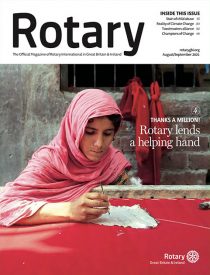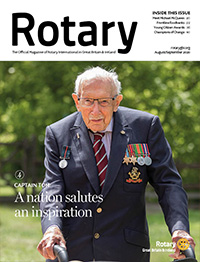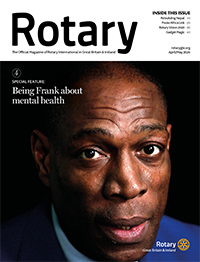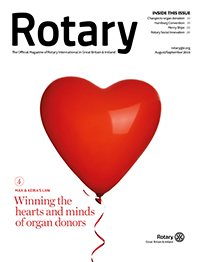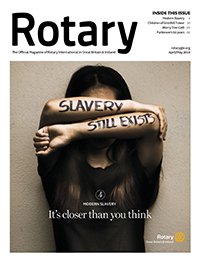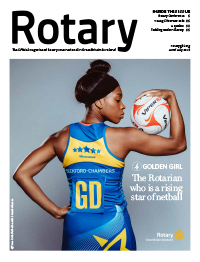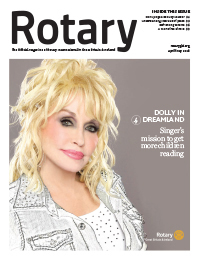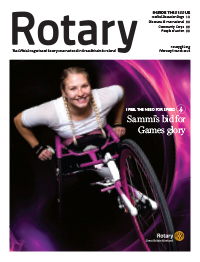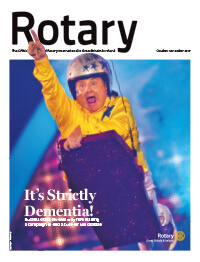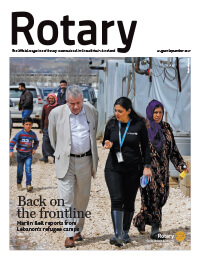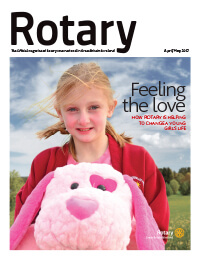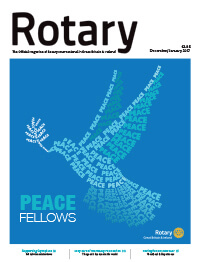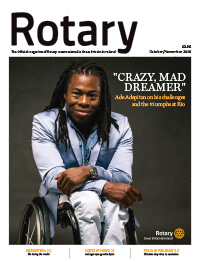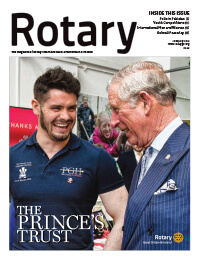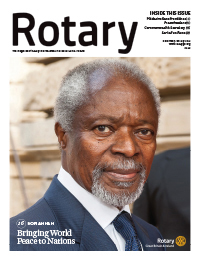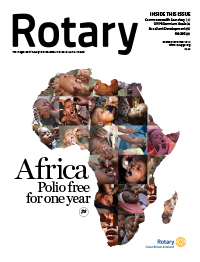It was in 1989 when decades of resistance to women joining the organisation was broken with a landmark decision by Rotary’s Council of Legislation.
The reaction was overwhelming. By June 1990, the number of female Rotarians had skyrocketed to over 20,000 and by 2010, those figures had reached 195,000 – or 16% of Rotarians.
By July 2020, the figure had surpassed 277,000, or about 23%.
Listen to this article
Rotary in Great Britain and Ireland has had four female Presidents – Nan McCreadie in 2013-14, followed by Eve Conway (2016-17), Debbie Hodge (2018- 19) and Donna Wallbank (2019-20).
Rotary magazine gathered all four ladies together to gauge their reaction to this watershed moment in Rotary.
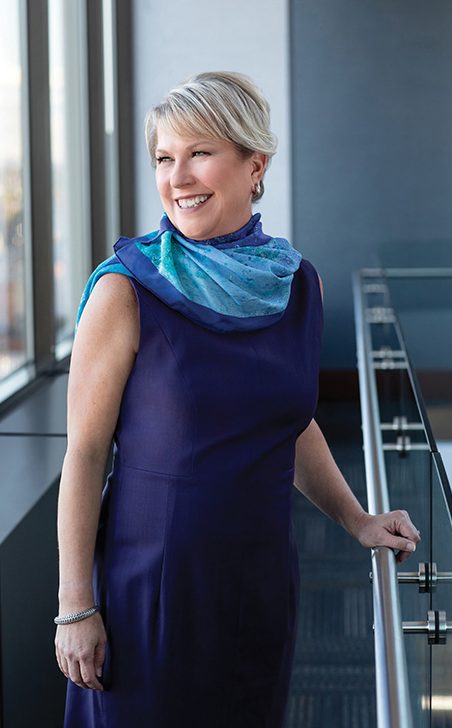

2022-23 Rotary International President Jennifer Jones. Rotary International World Headquarters, Evanston, Illinois, USA. 26 November 2021.
What are your thoughts on Jennifer Jones becoming Rotary’s first female president?
Donna: I believe Jennifer’s election as President is one where we acknowledge her ability to lead Rotary as a Rotarian, and we should not be taking her gender into account, as a post-selection should always be based on ability and not on the need to tick boxes that say well, we covered that one! That, in my opinion, undermines the efforts and commitment that any Rotarian has made to achieve and, in many ways, disrespects the achievements Jennifer has made for Rotary as a Rotarian. I am pleased to see the glass ceiling has been shattered and I hope that this appointment will be the first of many others as, with Jennifer’s enthusiasm to reach this level on the Board others, may be encouraged to continue even when it seems impossible.
Nan: I think it is extremely important that Jennifer Jones is becoming Rotary’s first female President. I don’t mean that, just because she is Jennifer; I mean it because we need to show that Rotary is no longer just a lunch club for men in suits, which seems to be a common belief in those who have even heard of Rotary. What is essential to remember is that she is becoming our President not because she’s a woman, it’s because she is the right person for the position.
Debbie: This has the feeling of breaking a glass ceiling, and will be a reminder to all in Rotary that we are an organisation that is open at all. From a personal perspective, with more women holding senior leadership posts in the organisation it is great to see that a woman has the top job. After all, 51% of the population are women!
Eve: You could say, after 117 years, that it’s about time! I am delighted that a fellow media professional Jennifer Jones is the first female President of Rotary International. I have known Jen as a Rotary colleague and friend for a number of years and it was great when, as RI Vice-President, she joined us for Rotary International in Great Britain and Ireland’s Conference in Manchester in 2017 when I was President of Rotary GB&I. She wow-ed us all with her warmth and great engaging personality. She is breaking a glass ceiling but has reached this top role through her impressive abilities and achievements within Rotary and in her professional life outside of Rotary, not as a token woman. Having said that, this shows other women that they can get to the top of our organisation. She is a wonderful role model. I am looking forward to working with her on the Rotary International Board.
How important is Jennifer’s appointment?
Donna: The importance is to reiterate that we each have much to bring to Rotary and it highlights that Rotary is for everyone with a passion and that Rotary is inclusive.
Nan: Jennifer will bring a vibrant, passionate, youthful image to Rotary. She has the communication skills to ensure the right message is being sent. She should not be regarded or reported as a pretty doll. She is highly intelligent, highly articulate and supported by a very good team.
Debbie: If the organisation wants to live by its values, then you could say this is overdue. But it does mark a turning point and should enable more women to aspire to leadership.
Eve: Women in Rotary are still under-represented compared to the general population making up just 23% of our members globally. A key focus now for
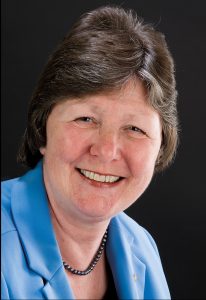

Nan McCreadie, Rotary Great Britain and Ireland President of 2013-14
Rotary is diversity, equity and inclusion, so Jennifer’s appointment shows that Rotary is embracing this and practices what it preaches. Jennifer will also be focusing on diversity, equity and inclusion as RI President. In terms of public relations, this shows that Rotary is diverse which will encourage more women and others to join us. For those outside of Rotary, it dispels the myth that many people still believe that women are not allowed into Rotary.
What do you hope Jennifer will achieve during her year as president?
Donna: I hope Jennifer continues to enthuse others with her passion and professional attitudes. I hope she will enable further opportunities to promote Rotary work across all areas of the globe, focussing on how the family of Rotary is included in all we do. Whoever we are, we each have a part to play in developing more opportunities for our community to know about what we do and for us each to open doors for membership for all. This ensures those with a passion and heart to do good, whoever they are, know they can be part of the great Rotary story.
Nan: I hope Jennifer will put Rotary into a much more central position in terms of who we attract and what we do. Perhaps a kinder face than previously displayed, no offence to previous Presidents. I hope she will be able to position Rotary as the number one humanitarian organisation which can get things done.
Debbie: I hope that Jennifer will be able to challenge the status quo that is still evident in some parts of the Rotary world but, more importantly, inspire the next generation to take the brave step to ‘step up to lead’!
Eve: Jennifer is already setting out her vision of what she hopes to achieve with her ‘Imagine Rotary’ theme. Using her media background, I not only hope but know Jennifer will raise the profile of Rotary as she is already demonstrating with her plans to take the Rotary story on the road on an ‘Imagine Impact Tour’ for her Presidential travels, visiting visible, high impact Rotary projects globally across all of our seven Areas of Focus as well as our End Polio Now campaign to shine a bright light on the incredible work that Rotarians are doing. This will increase our impact and expand our reach and attract people to want to join our incredible organisation. With each of the stops on her tour, Jennifer says there will be a different media approach to raise awareness to “ignite some Aha moments” as the world sees the good work that Rotary is doing with top tier media journalists to help tell our story and influencers who will use their social media presence to reach people who have wanted to serve but have not yet realised they can do it through Rotary.
Has Rotary progressed in terms of the recruitment of female Rotarians since you were Rotary GB&I President?
Donna: I believe we are seeing a better inclusion of Rotarians from all genders and areas of life, however, I remain firm in the view that once we see someone with an interest in doing for Rotary gender, their skin colour, sexuality, income etc. Should not be focused on. This only makes those who believe Rotary is for their gender and their type of person, more adamant not to invite someone unlike them to join Rotary – or even vote against them being admitted. We should show people that whoever we are and wherever we are from, Rotarians come to Rotary service with a passion and heart to do good. We want to contribute to society and, in showcasing that we will continue to change the perceptions of those who do not agree with that thinking. I still think there are many areas of society underrepresented in our membership and we still have much to do to ensure people of action come from all walks of life.
Nan: I have always believed that we are all Rotarians. No one talks about male Rotarians. In my attempts to recruit new members, I have tried to be inclusive although I confess to leanings towards my own gender. I believe the organisation benefits from its dual-gender policy. There are areas of the world where this may not be possible, but Rotary should be encouraging membership from all sectors of the community and all ages. I believe Jennifer is perfectly positioned to carry that encouragement further than previously.
Debbie: There is much more conversation about increasing the number of women in Rotary, but this sits alongside the premise that our clubs should be representative of our communities. In that respect, there is a long way to go in some areas. In others, there is a much better grasp of the issues and that is reflected in the diversity and inclusivity in some clubs and districts.
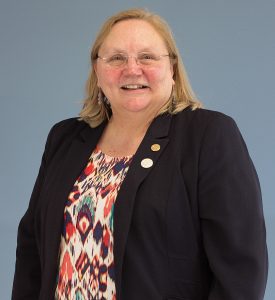

Debbie Hodge Rotary Great Britain and Ireland President from 2018-19.
Eve: The numbers have gone up slightly from when I was President but at 23%t globally, we still aren’t truly reflecting our population. In 2020, 50.59% of the population in the UK were women. But take a look at Rotaract which has already achieved parity with 51% of its members being female. What should hopefully encourage the recruitment of more female Rotarians is the progress we are making in seeing more women in top roles at Rotary International like Jennifer Jones. This Rotary year, there are nine women out of the 20 leaders serving on the Rotary International Board. And I was delighted to be elected as RI Director for 2023-25 which shows more women are taking on these roles.
What more could be done to increase the number of female Rotarians?
Donna: I think every Rotarian should ask their membership group to review their membership statistics, not just based on gender. If there
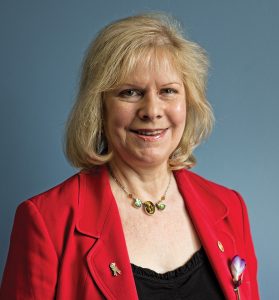

Eve Conway Rotary Great Britain and Ireland President from 2016-17.
are gaps, we should ask why they exist and then take time to create a people-focused community development action plan. Perhaps what is missing is the public are unaware of the demographic changes in Rotary today because those Rotarians on duty or who are out and about, are possibly the same type of Rotarians they have always seen. Perhaps that is because these new Rotarians are at work, at home or unavailable, so the ‘new’ image isn’t being promoted at local levels. We need to grow awareness, utilising Rotary membership models, our modernisation, equality and diversity, whenever and wherever we can.
Nan: Given that clubs now have more flexibility than ever before in recruitment and format, it should be possible to reach other parts of the community and age groups that may not have been possible when I was President of Rotary GB&I. Look, for instance, at Maidenhead Bridge Rotary, which is very vibrant and uses the flexibility in meeting times and attendance to encourage younger people and families to commit.
Debbie: We need to not just speak of our values but live by them, and we must remember that everyone has a contribution to making the world a better place locally, nationally and internationally. Our behaviours must reflect those values and our clubs shoul
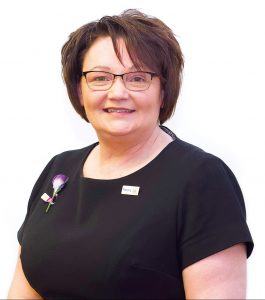

Donna Wallbank Rotary Great Britain and Ireland President 2019-20.
d be places where anyone, including women, feels comfortable in making that contribution.
Eve: Rotary needs to be seen as relevant and representing the communities we serve with not just more women but younger members and more ethnic diversity. We need to get the message out that Rotary is a welcoming environment for all and our clubs should reflect that. So, to increase female members, we need to see women visible at every level of Rotary: club, district, nationally and internationally. I was encouraged to see when producing 30 videos for Rotary’s membership and marketing campaign, that more women are being attracted to join Rotary when they find out that we are ‘People of Action’. The flexibility of new style clubs as well as cause-based and passport clubs is also attracting a new demographic. The pandemic has shown us that people want to volunteer to help their communities and this is an open invitation for us to bring more like-minded people into Rotary – including women – and build our membership. We can grasp this opportunity!









